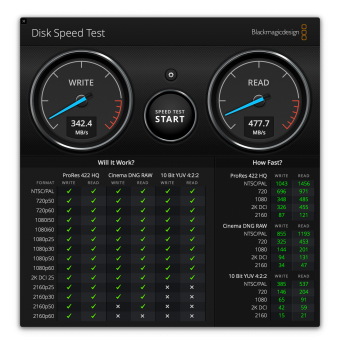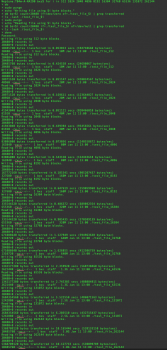Subject: Pros & Cons using Apple’s Disk Utility vs. SoftRAID for Managing RAID sets ?
I’ve been using Apple’s Disk Utility (DU) for ages and purchased a SoftRAID full license in Dec 2015 to handle RAID sets beyond what DU offered. The prospect of configuring RAID-5 using SoftRAID appealed to me for protecting against a single drive failure. DU did not provide for this.
Today, I’m wrestling with the use of DU vs. SoftRAID for configuring RAID-0 for our MP7,1’s internal/external units; in particular our Sonnet PCIe card with its 4x Samsung SSD/Flash blades.
In some articles I’ve read there’s mention that SoftRAID offers as much as 85% better RAID-0 performance than for DU’s RAID-0. I’m unclear what the basis is for this claimed 85%.
With this unclear issue of which is best, DU or SoftRAID, I’ve spent a limited amount of time to see just what the differences are configuring RAID-0 on a set of 4x 5TB 2.5” Seagate BarraCuda 5400 RPM spinning disks in an OWC Thunderbolt 2 mini 4 enclosure (TB4m).
The 5TB disks were freshly erased and formatted as HFS+. I ran the tests under Catalina 10.15.3 (Build 19D49f) on my late 2016 15" rMBP13,3. The TB4m was directly attached to the MBP using Apple's USB-C-to-TB2 adapter.
After configuring these 4x BarraCuda drives as RAID-0 using both DU and SoftRAID I used AJA, BlackMagic Disk Test and the Terminal command dd to establish some data rates for each.
In each case I set the RAID-0 transfer block size to 128Kb.
Using AJA and BlackMagic I found little difference between using DU and SoftRAID. The AJA data rates came out to be around 518 MB/s for writes and a bit less at 490 MB/s for reads, using 1GB file sizes. The BlackMagic rates for writes were quite bad but the reads were close to what AJA displayed (does BlackMagic avoid using the kernel file buffer cache?). No matter, the take-away was there was little difference between using DU vs. SoftRAID.
I ran a serious of dd writes & reads using different transfer block sizes from 512 bytes up to 262144 bytes, and for file sizes ranging from 10.5 MB up to 5.37 GB and the best write rate was some 583 MB/s and for reads the best was 510 MB/s. This was done such that the kernel File buffer cache was being cleared using ’sudo purge’ between runs to avoid reading from the RAM file cache.
So the dd command was showing slightly better write & read rates compared to AJA & BlackMagic.
This limited testing showed me there was little performance difference using DU or SoftRAID for RAID-0.
I guess I will use the same testing procedure for the Sonnet/Samsung RAID-0 comparison and I suspect there will little variance using the Apple’s DU vs. using SoftRAID.
Attached: AJA, BlackMagic and Terminal dd command displays/outputs for using Apple’s DU for RAID-0.
I’ve been using Apple’s Disk Utility (DU) for ages and purchased a SoftRAID full license in Dec 2015 to handle RAID sets beyond what DU offered. The prospect of configuring RAID-5 using SoftRAID appealed to me for protecting against a single drive failure. DU did not provide for this.
Today, I’m wrestling with the use of DU vs. SoftRAID for configuring RAID-0 for our MP7,1’s internal/external units; in particular our Sonnet PCIe card with its 4x Samsung SSD/Flash blades.
In some articles I’ve read there’s mention that SoftRAID offers as much as 85% better RAID-0 performance than for DU’s RAID-0. I’m unclear what the basis is for this claimed 85%.
With this unclear issue of which is best, DU or SoftRAID, I’ve spent a limited amount of time to see just what the differences are configuring RAID-0 on a set of 4x 5TB 2.5” Seagate BarraCuda 5400 RPM spinning disks in an OWC Thunderbolt 2 mini 4 enclosure (TB4m).
The 5TB disks were freshly erased and formatted as HFS+. I ran the tests under Catalina 10.15.3 (Build 19D49f) on my late 2016 15" rMBP13,3. The TB4m was directly attached to the MBP using Apple's USB-C-to-TB2 adapter.
After configuring these 4x BarraCuda drives as RAID-0 using both DU and SoftRAID I used AJA, BlackMagic Disk Test and the Terminal command dd to establish some data rates for each.
In each case I set the RAID-0 transfer block size to 128Kb.
Using AJA and BlackMagic I found little difference between using DU and SoftRAID. The AJA data rates came out to be around 518 MB/s for writes and a bit less at 490 MB/s for reads, using 1GB file sizes. The BlackMagic rates for writes were quite bad but the reads were close to what AJA displayed (does BlackMagic avoid using the kernel file buffer cache?). No matter, the take-away was there was little difference between using DU vs. SoftRAID.
I ran a serious of dd writes & reads using different transfer block sizes from 512 bytes up to 262144 bytes, and for file sizes ranging from 10.5 MB up to 5.37 GB and the best write rate was some 583 MB/s and for reads the best was 510 MB/s. This was done such that the kernel File buffer cache was being cleared using ’sudo purge’ between runs to avoid reading from the RAM file cache.
So the dd command was showing slightly better write & read rates compared to AJA & BlackMagic.
This limited testing showed me there was little performance difference using DU or SoftRAID for RAID-0.
I guess I will use the same testing procedure for the Sonnet/Samsung RAID-0 comparison and I suspect there will little variance using the Apple’s DU vs. using SoftRAID.
Attached: AJA, BlackMagic and Terminal dd command displays/outputs for using Apple’s DU for RAID-0.
Attachments
Last edited:




